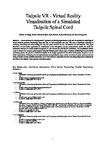Tadpole VR: virtual reality visualization of a simulated tadpole spinal cord
| dc.contributor.author | Varga, Marius Nicolae | |
| dc.contributor.author | Merrison-Hort, R | |
| dc.contributor.author | Watson, Paul | |
| dc.contributor.author | Borisyuk, Roman | |
| dc.contributor.author | Livingstone, D | |
| dc.contributor.editor | Ballin D | |
| dc.date.accessioned | 2020-03-09T16:04:06Z | |
| dc.date.issued | 2021-03 | |
| dc.identifier.issn | 1359-4338 | |
| dc.identifier.issn | 1434-9957 | |
| dc.identifier.uri | http://hdl.handle.net/10026.1/15441 | |
| dc.description.abstract |
Recent advances in “developmental” approach (combining experimental study with computational modelling) of neural networks produces increasingly large data sets, in both complexity and size. This poses a significant challenge in analyzing, visualizing and understanding not only the spatial structure but also the behavior of such networks. This paper describes a Virtual Reality application for visualization of two biologically accurate computational models that model the anatomical structure of a neural network comprised of 1,500 neurons and over 80,000 connections. The visualization enables a user to observe the complex spatio-temporal interplay between seven unique types of neurons culminating in an observable swimming pattern. We present a detailed description of the design approach for the virtual environment, based on a set of initial requirements, followed up by the implementation and optimization steps. Lastly, the results of a pilot usability study are being presented on how confident participants are in their ability to understand how the alternating firing pattern between the two sides of the tadpole’s body generate swimming motion. | |
| dc.format.extent | 1-17 | |
| dc.language | English | |
| dc.language.iso | English | |
| dc.publisher | Springer Science and Business Media LLC | |
| dc.subject | Data visualization | |
| dc.subject | Neuroscience | |
| dc.subject | Virtual Reality | |
| dc.subject | Visualization | |
| dc.subject | Scientific Visualization | |
| dc.subject | Immersive | |
| dc.title | Tadpole VR: virtual reality visualization of a simulated tadpole spinal cord | |
| dc.type | journal-article | |
| dc.type | Journal Article | |
| plymouth.author-url | http://mariusvarga.co.uk/ | |
| plymouth.issue | 1 | |
| plymouth.volume | 25 | |
| plymouth.publication-status | Published | |
| plymouth.journal | Virtual Reality | |
| dc.identifier.doi | 10.1007/s10055-020-00431-z | |
| plymouth.organisational-group | /Plymouth | |
| plymouth.organisational-group | /Plymouth/Faculty of Science and Engineering | |
| plymouth.organisational-group | /Plymouth/Faculty of Science and Engineering/School of Engineering, Computing and Mathematics | |
| plymouth.organisational-group | /Plymouth/REF 2021 Researchers by UoA | |
| plymouth.organisational-group | /Plymouth/REF 2021 Researchers by UoA/UoA11 Computer Science and Informatics | |
| plymouth.organisational-group | /Plymouth/Users by role | |
| plymouth.organisational-group | /Plymouth/Users by role/Academics | |
| plymouth.organisational-group | /Plymouth/Users by role/Researchers in ResearchFish submission | |
| dcterms.dateAccepted | 2020-02-28 | |
| dc.rights.embargodate | 2021-3-14 | |
| dc.identifier.eissn | 1434-9957 | |
| dc.rights.embargoperiod | Not known | |
| rioxxterms.version | Accepted Manuscript | |
| rioxxterms.versionofrecord | 10.1007/s10055-020-00431-z | |
| rioxxterms.licenseref.uri | http://www.rioxx.net/licenses/all-rights-reserved | |
| rioxxterms.type | Journal Article/Review | |
| plymouth.funder | Cross-modality integration of sensory signals leading to initiation of locomotion::BBSRC |


